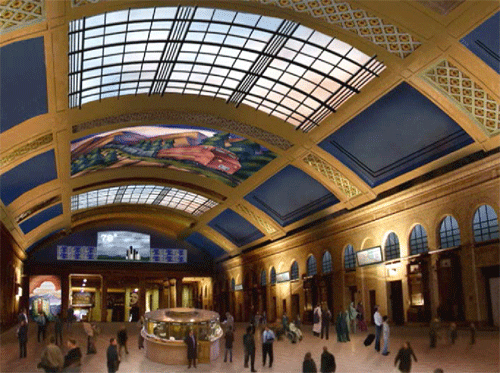

Share
It’s a multimodal transportation hub poised to serve the Twin Cities Metro. It’s an architectural jewel in St. Paul’s booming Lowertown district. And according to the results of a new study, the renovated Union Depot has been – and continues to be – an engine for job creation and economic growth.
The Union Depot rehabilitation project provided good return on taxpayers’ $243 million investment, according to “Work for All the Crafts,” a new study by Good Jobs First, a Washington-based policy organization that tracks public subsidies and promotes corporate and government accountability.
Backed by state, local and federal investment, including a $35 million TIGER grant from the U.S. Department of Transportation’s, rehabilitation of Union Depot created more than 660,000 hours of work for Building Trades craftspeople and apprentices.
The facility opened last year, but according to the report, Union Depot continues to spark economic development and create work for Building Trades unions today.
“In the surrounding Lowertown area of downtown St. Paul, private reinvestment is surging, including redevelopment of a large former U.S. Postal Service building,” the report reads.
Metro Transit’s newest light-rail line, the Green Line, will begin service Saturday, with Union Depot serving as the end of the line downtown St. Paul. Together, the transportation investments have triggered a surge in development, with more than 120 private projects underway or in the works.
“Even before trains start running, more than $2.2 billion in additional construction activity has been permitted along the route – and more than a third of the slated projects have not yet announced their dollar values,” the report reads.
Greg LeRoy, lead author of Good Jobs First’s report, said that’s more good news for Building Trades members.
“Taxpayer investments that stimulate transit and transit-oriented development are excellent job creators that can also redress historical racial disparities,” LeRoy said. “It’s exciting to see so many skills on display. No wonder the Trades made the Depot a showcase for their apprenticeship programs.”
The report also notes that the project exceeded its diversity targets – 18.9 percent went to workers from minority groups, 6.9 percent to women workers – and provided training opportunities for workers entering careers in the Building Trades.
“Minnesota’s labor-management training programs made the Depot a showcase for career-building opportunities, complete with video and high-school road show,” the report reads.
Although a transportation project, Union Depot’s renovation created work for Building Trades unions that don’t usually benefit from transportation investments, including the Electrical Workers, Pipe Trades, Bricklayers, Sheet Metal Workers, Roofers and Painters.
“About 2,000 members of at least 13 Building Trades unions brought the St. Paul Union Depot back to life,” the report reads. “Especially in the restoration and modernization of the Depot’s visual centerpiece – its waiting room with historical friezes and a barrel vaulted ceiling and skylight – the job involved highly skilled craftsmanship from numerous trades.”

